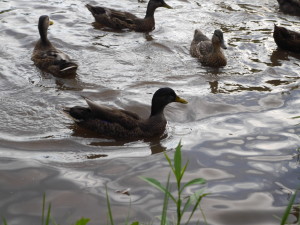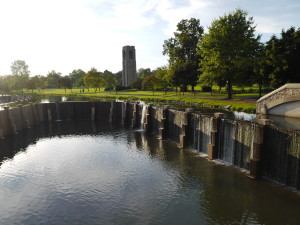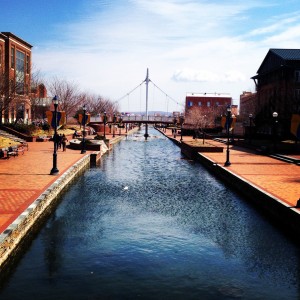By Mary Milligan
Several waterways in Frederick are polluted with potentially harmful bacteria that become especially elevated after rainfall.
This bacteria, enterococcus, can cause a stomach ache and similar ailments according to Sara Eckard, a biology major and water researcher. In Frederick, it has been found in Carroll Creek, Culler Lake, Rock Creek, Owens Creek in Thurmont, Glade Run in Walkersville, and a tributary that runs in front of Frederick High and into Carroll Creek.

Professor of Biology and Director of Coastal Studies Program Dr. Drew Ferrier said that the summer project began with a feeling that people had a hard time understanding the status of the environment. He said that they wanted to do the research to produce a “clearer way of expressing to the public an indication of the pollution in the water.”
Eckard and Dr. Drew Ferrier began to look at the enterococcus levels of different waterways over the summer in partnership with the Chesapeake Bay Foundation. The levels they found are significantly higher than those recommended by the EPA standard for wading or swimming. The water is not extremely harmful unless ingested.
Enterococcus is a bacterium that is found in fecal matter, according to Eckard. It is unknown what species caused the elevation. She said it could be from ducks and geese or dogs and other mammals.

The Maryland Department of the Environment (MDE) regularly monitors waterways year round. In order to develop a budget to improve the water quality of impaired waterways, according to the MDE website.
Shannon Moore, Frederick County Sustainability and Environmental Resources manager said that in addition to the enterococcus there is also E. coli in the water.
Although the work of Eckard and Ferrier focused on Frederick County waterways, this is an issue that impacts waterways throughout Maryland. According to the MDE website, these include beaches and other various recreational waterways throughout the state.
The reasoning for this testing is so people are aware of what is in the water that they are wading in. There is no immediate threat, but there is the potential for the bacteria to be the harmful, according to Eckard.
The concern with this in the Frederick area especially is that the waterways in which the bacteria is found is water that children often wade in. While it is not an emergency situation, enterococcus can harm people and they need to be aware of that.

Eckard said that if fecal source tracking was done they would better be able to identify a way to prevent the increase of the bacteria in the water. “If it’s just coming from duck, geese and things like that, there’s nothing we can really do about it. If it’s waste coming from farms or a human source, then we could do something about that,” Eckard said.
Ferrier said that they may be able to reduce the amount of bacteria once they determine the source. If it is pets, they can set up an educational program about picking up pet waste for the public.
If it is found to be human waste the sewage system can be inspected and repaired if anything is wrong with it. Often times it is found to be an issue with farms. There is a foundation that would help farmers set up stream bank fencing to prevent cows from wading in the water.
Ferrier said that they hope to continue the project this summer and will be able to do bacterial source tracking on the water. This would provide them with the information on where the enterococcus is coming from.
Moore, said that there is a lack of long time data in the area, therefore it is unknown if the bacteria is due to the growth of Frederick. However, she explained that if it found that the bacteria are from pet waste or the septic and sewer systems which would increase with the population.
Moore said, “Bacteria also binds to sediment, so where increased impervious surface causes greater erosion that could result in more loads to streams from these sources.”
In the more developed areas where there are more roads, there are fewer places for the rain to filter through the ground. This causes more unwanted bacteria, chemicals, and elements to flow into waterways.
Eckard also encourages the use of rain barrels and building more rain gardens. This prevents the rain runoff from going from the road straight to the stream.
Moore comments that the urbanization is also sometimes helpful for reducing bacteria in the water. While erosion could result in more loads of bacteria in streams, if the previous use of the land was pasture the load could have been higher.
This summer as the research continues Ferrier and his team will also test for E. coli. Moore said, “We are putting together restoration plans to address E. coli Total Maximum Daily Loads for the three watersheds in Frederick that have them.”
The three watersheds that they plan to address are: Double Pipe Creek, Upper Monocacy, and Lower Monocacy. These will be reviewed with the elected officials and then submitted to MDE by July 1, according to Moore.
The bacteria in the water are a problem that is continuously being examined in order to reach the source, promote awareness for cleaner waterways, and determine the best way to remove the bacteria.